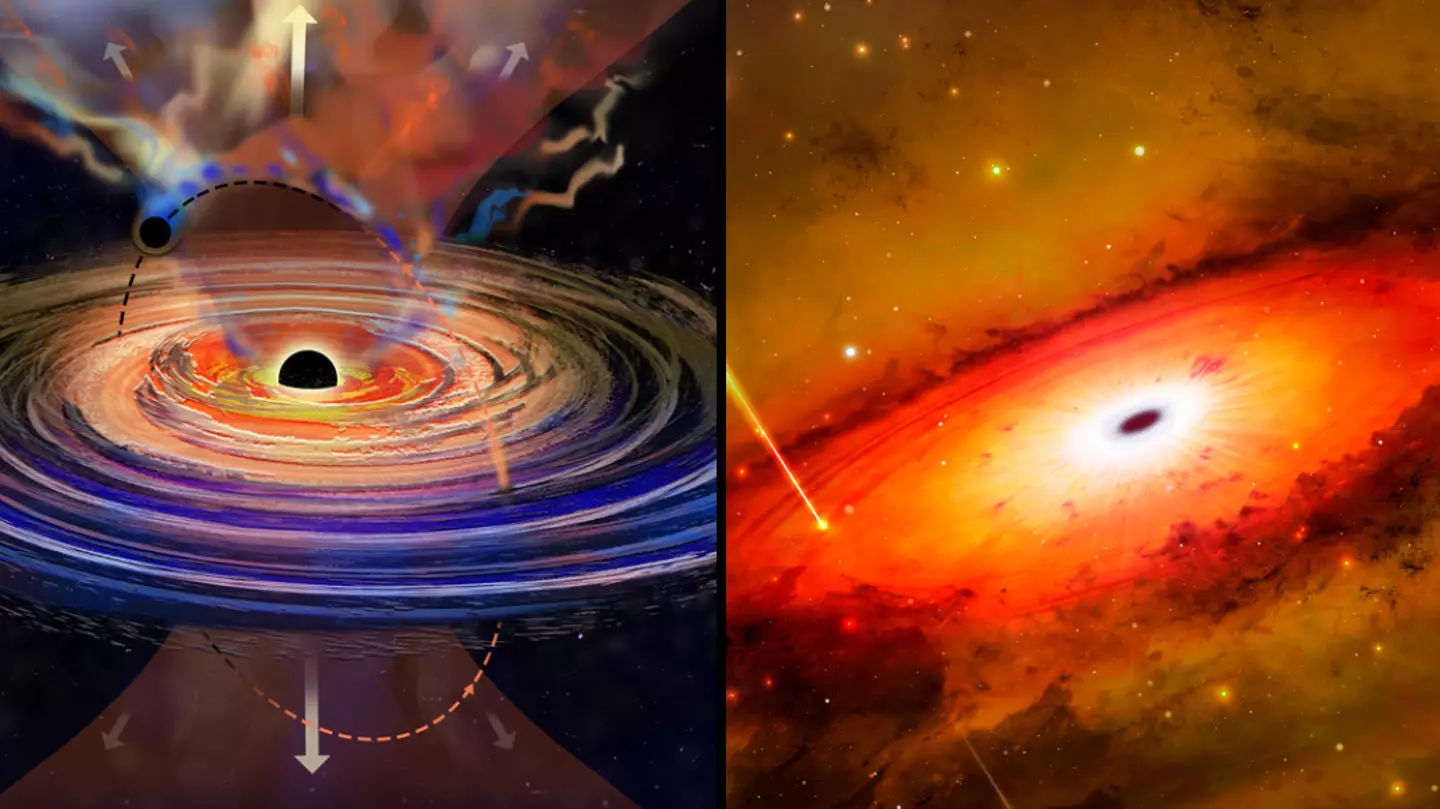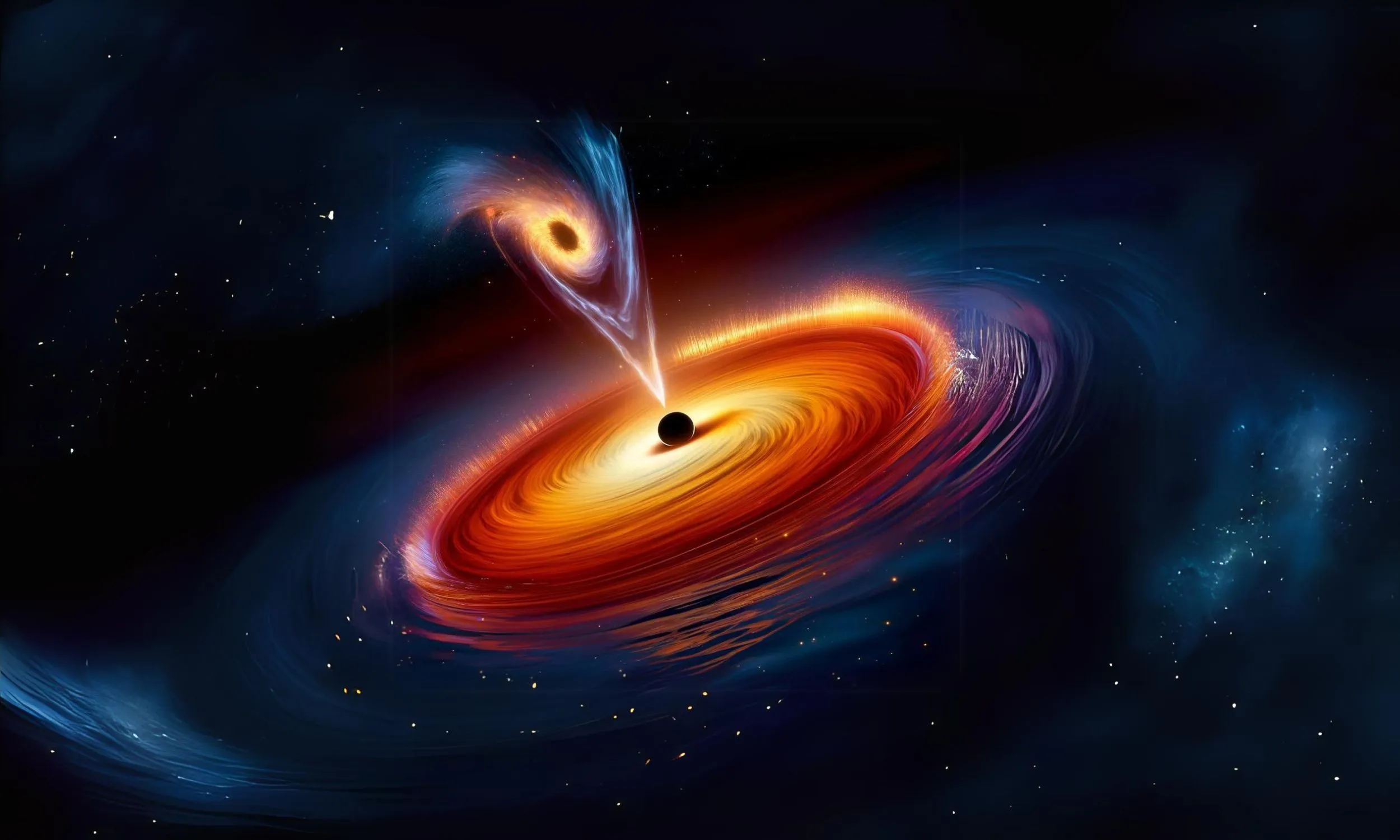Supermassive Black Hole Emits Burst of Energy After Swallowing Gas: Understanding the Cosmic Hiccup

Imagine a cosmic hiccup shaking the fabric of space, a sudden burst of energy from a supermassive black hole that’s just devoured a swirling cloud of gas.
Anúncios
This isn’t science fiction—it’s the universe’s latest spectacle, captivating astronomers and rewriting our understanding of these enigmatic giants.
When a black hole “burps” after consuming matter, it sends shockwaves of X-rays and gamma rays across galaxies, offering a rare glimpse into the chaotic heart of the cosmos.
But what triggers this phenomenon, and why does it matter?
Let’s dive into the science, the surprises, and the cosmic implications of these energetic outbursts, exploring how they challenge our assumptions and ignite new questions about the universe.
The Anatomy of a Cosmic Hiccup
At the core of nearly every massive galaxy lies a supermassive black hole, a gravitational titan with a mass millions or billions of times that of our Sun.
These behemoths don’t just sit idly; they actively shape their surroundings by pulling in gas, dust, and even stars.
When a black hole consumes a significant amount of material, it doesn’t always do so quietly.
The process can trigger a cosmic hiccup—a sudden, powerful emission of energy that lights up the sky in high-energy wavelengths.
This outburst, often detected as X-ray flares or gamma-ray bursts, occurs when the infalling material heats up in the accretion disk, a swirling vortex of matter spiraling toward the event horizon.
Think of the accretion disk as a cosmic blender, where gas and dust are churned at extreme temperatures, reaching millions of degrees Kelvin.
The friction and compression generate intense radiation, but the cosmic hiccup happens when something disrupts this process—perhaps a sudden influx of gas or a collision with a stellar remnant.
For example, picture a black hole in the galaxy SDSS1335+0728, nicknamed Ansky, which began emitting extraordinary X-ray flares in late 2019.
These bursts, identified as quasi-periodic eruptions (QPEs), were 10 times brighter and lasted 10 times longer than typical black hole outbursts, releasing 100 times more energy.
This discovery, observed by ESA’s XMM-Newton and NASA telescopes, underscores the unpredictable nature of these events and their potential to reveal new physics.
You can read more about Ansky’s fascinating behavior here.
Why Do Black Holes “Hiccup”?
The question of what causes a cosmic hiccup is both tantalizing and complex.
Astronomers hypothesize that these bursts stem from disruptions in the accretion disk.
One leading theory suggests that a smaller object—perhaps a star or a stellar-mass black hole—periodically plunges through the disk, creating shockwaves that manifest as X-ray flares.
Imagine a pebble tossed into a spinning whirlpool: the ripples it creates are akin to the energy bursts we detect.
In Ansky’s case, researchers propose that a small object crosses the accretion disk every 4.5 days, causing the observed QPEs.
This rhythmic pattern challenges the traditional view of accretion disks as uniform, suggesting a more dynamic and chaotic environment.
Another possibility involves the black hole’s magnetic fields.
As gas spirals inward, it drags magnetic field lines, twisting them into a cosmic slingshot.
When these fields snap or reconnect, they can unleash a torrent of energy, producing a cosmic hiccup.
This mechanism is particularly relevant for rotating black holes, where the spin amplifies the magnetic effects.
For instance, consider a fictional black hole in the galaxy NGC-9876, where a sudden influx of gas from a nearby supernova remnant triggers a magnetic reconnection event, resulting in a gamma-ray burst visible across millions of light-years.
Such scenarios highlight the interplay between a black hole’s environment and its energetic outbursts.
The Cosmic Implications of These Bursts
Why should we care about a cosmic hiccup?
These bursts are more than just celestial fireworks—they’re windows into the fundamental laws of physics.
By studying the energy emissions, astronomers can probe the conditions near the event horizon, a region where gravity warps space-time to extremes.
The X-ray flares from Ansky, for example, offer clues about the accretion disk’s structure and the black hole’s spin, which could validate or challenge predictions from Einstein’s general relativity.
Moreover, these events may produce gravitational waves, detectable by future missions like ESA’s Laser Interferometer Space Antenna (LISA), set to launch in the 2030s.
Beyond physics, cosmic hiccups influence galactic evolution.
The energy released can heat surrounding gas, preventing it from cooling and forming new stars.
This feedback mechanism regulates star formation, shaping the galaxy’s growth over billions of years.
In a hypothetical galaxy, Zeta-12, a supermassive black hole’s repeated outbursts might quench star formation, leaving the galaxy dimmer and less active than its neighbors.
This process underscores the black hole’s role as a cosmic architect, sculpting the universe on a grand scale.
A Statistical Snapshot
To grasp the scale of these phenomena, consider this: a single cosmic hiccup from a supermassive black hole can release as much energy in a few hours as our Sun will emit over its entire 10-billion-year lifetime.
This staggering statistic highlights the immense power of these events and their potential to disrupt their cosmic neighborhoods.
To further illustrate, let’s examine the characteristics of known QPEs:
| Black Hole | Galaxy | Burst Duration | Energy Output (ergs) | Periodicity |
|---|---|---|---|---|
| Ansky | SDSS1335+0728 | ~10 hours | 10^44 | 4.5 days |
| GSN 069 | GSN 069 | ~1 hour | 10^42 | 9 hours |
| RX J1301.9 | RX J1301.9+2747 | ~20 minutes | 10^41 | 13.5 hours |
This table compares Ansky’s QPEs with other known systems, showing its exceptional duration and energy output.
The scale of energy involved in these events emphasizes their significance in understanding black hole dynamics and their effects on surrounding matter.

The Role of Technology in Unraveling the Mystery
Advancements in observational technology have been crucial in detecting and studying cosmic hiccups.
Telescopes like NASA’s Chandra X-ray Observatory and the Neil Gehrels Swift Observatory capture the high-energy signatures of these bursts, while the James Webb Space Telescope (JWST) provides complementary data on the surrounding galactic environment.
For example, JWST’s mid-infrared observations can detect changes in the accretion disk’s spectral index, offering insights into the physical conditions during a flare.
These tools allow astronomers to piece together the puzzle of black hole behavior, revealing patterns that were once invisible.
The coordination of multiple observatories is equally vital.
In the case of Ansky, data from ESA’s XMM-Newton, NASA’s NICER, and India’s AstroSat telescope converged to map the timing and intensity of the X-ray flares.
This multi-wavelength approach is like assembling a cosmic jigsaw puzzle, where each piece—X-rays, optical light, radio waves—reveals a different facet of the event.
As technology evolves, future missions like LISA will add gravitational wave data, potentially confirming whether these bursts are linked to orbiting objects or other dynamic processes.
+ The Role of Infrared Light in Discovering Hidden Galaxies
Challenges and Unanswered Questions
Despite these advancements, cosmic hiccups remain shrouded in mystery.
Current models struggle to explain the extreme properties of Ansky’s flares, with some researchers noting that “the number of theoretical models exceeds the available data.”
This gap highlights the need for more observations and refined simulations.
For instance, why do some black holes produce regular QPEs while others remain silent?
The answer may lie in the black hole’s mass, spin, or the composition of its accretion disk, but we lack the data to be certain.
Another challenge is the dust that often obscures these events.
In the early universe, supermassive black holes are frequently hidden by thick clouds of gas and dust, making their outbursts difficult to detect.
The Atacama Large Millimeter Array (ALMA) has begun to overcome this barrier by using radio waves to penetrate the cosmic fog, as demonstrated in a 2025 study of a black hole 12.9 billion years old.
This breakthrough suggests that many more cosmic hiccups may be waiting to be discovered, hidden in the distant past.
A Broader Cosmic Context
To put cosmic hiccups in perspective, consider them as part of the universe’s energetic symphony.
Black holes are not isolated; they interact with their environments in complex ways.
The jets they produce, often associated with these bursts, can stretch millions of light-years, carrying energy far beyond the galaxy’s borders.
These jets, composed of near-light-speed plasma, convert visible and infrared light into high-energy gamma rays, a process that remains poorly understood.
By studying these jets, we can learn how black holes influence cosmic structures, from galaxy clusters to the intergalactic medium.
The analogy of a cosmic hiccup is apt: just as a hiccup disrupts our breathing, these bursts disrupt the steady rhythm of a black hole’s feeding.
But unlike our fleeting discomfort, a black hole’s hiccup can reshape entire galaxies.
This dynamic interplay raises a profound question: Could these bursts be the universe’s way of balancing its own growth, ensuring that galaxies don’t form stars too quickly or collapse under their own gravity?
It’s a question that invites us to rethink the cosmos as a living, breathing system.

Future Horizons
Looking ahead, the study of cosmic hiccups promises to unlock new frontiers.
Upcoming missions like LISA and the Square Kilometre Array (SKA) will provide unprecedented sensitivity, allowing us to detect fainter bursts and their gravitational wave signatures.
These tools could confirm whether small objects, like stars or black holes, are indeed responsible for the rhythmic flares.
Meanwhile, simulations grounded in general relativity are helping to model the complex dynamics of accretion disks, offering predictions that can be tested against observations.
To illustrate the potential, consider a future observation of a black hole in the galaxy M-456, where SKA detects a series of radio bursts linked to a cosmic hiccup.
By combining this data with LISA’s gravitational wave detections, astronomers could pinpoint the orbit of a companion object, revealing its mass and trajectory.
Such discoveries would not only validate current theories but also open new avenues for exploring black hole interactions.
++ Rogue Planets: How Scientists Detect These Dark Celestial Bodies
A Call to Cosmic Curiosity
The universe is full of surprises, and the cosmic hiccup is one of its most dramatic.
These bursts remind us that even the most massive objects in the cosmos are not static—they pulse, flare, and reshape their surroundings in ways we’re only beginning to understand.
As we peer deeper into the hearts of galaxies, each outburst offers a chance to test our theories, challenge our assumptions, and marvel at the universe’s complexity.
| Mission | Launch Year | Key Capability | Relevance to Cosmic Hiccups |
|---|---|---|---|
| LISA | 2035 | Gravitational wave detection | Detects waves from objects causing QPEs |
| SKA | 2028 | Radio wave sensitivity | Maps radio bursts linked to accretion disk shocks |
| Athena | 2037 | X-ray spectroscopy | Analyzes energy spectra of flares |
This table outlines future missions that will enhance our understanding of cosmic hiccups, each bringing a unique perspective to the phenomenon.
So, what will the next cosmic hiccup reveal about the universe’s hidden workings?
As we continue to explore, one thing is clear: these bursts are not just fleeting events but cosmic signals, inviting us to decode the secrets of the black holes that shape our universe.
Let’s keep watching the skies, ready for the next surprise from the cosmos’s most mysterious giants.
